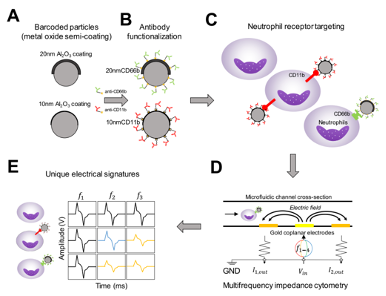
Graphical overview depicts the detection of electrically-sensitive cell membrane receptors: (A) Microparticles with varied aluminum oxide coatings (20nm and 10nm) are (B) coated with specific antibodies (anti-CD66b for 20 nm, anti-CD11b for 10nm) to (C) target inflammatory neutrophil receptors, resulting in cell-particle conjugates indicating receptor presence. (D) Individual object measurements occur in flowing conditions using microfluidic impedance cytometry, applying multiple frequencies to (E) distinguish the coating-thickness-dependent frequency responses of aluminum oxide-coated microparticles.

Invention Summary:
The majority of in vitro diagnostics are created to detect a single biomarker. There is an unmet need for a point-of-care device that can simultaneously identify multiple biomarkers to ensure precise diagnosis and prognosis of complex diseases.
Rutgers researchers have developed an invention that pertains to a cytometry device using multifrequency impedance for identifying microparticles that are barcoded and bound with antibodies at specific frequencies. These microparticles have a partial coating of various metal oxide thicknesses. By utilizing multi-frequency impedance cytometry and machine learning, cells expressing surface antigens that can be identified and captured by the microparticle-conjugated antibodies, as well as cell-microparticle complexes, can be distinguished from each other.
Market Applications:
- Identifying specific cell types through surface receptors or antigens
- POC device for disease diagnosis and/or prognosis
Advantages:
- Reduced costs in comparison to flow cytometry instruments
- Portable
- Ease of operation
Intellectual Property & Development Status: Patent pending. Available for licensing and/or research collaboration. For any business development and other collaborative partnerships contact marketingbd@research.rutgers.edu
Publications: Lab on a Chip